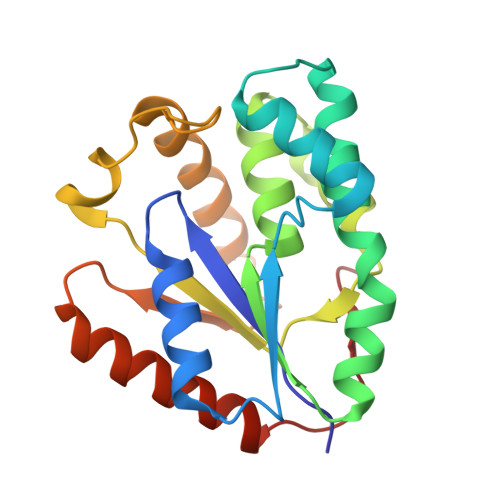Crystal Structure of Poxvirus Thymidylate Kinase: An Unexpected Dimerization Has Implications for Antiviral Therapy
Caillat, C., Topalis, D., Agrofoglio, L.A., Pochet, S., Balzarini, J., Deville-Bonne, D., Meyer, P.(2008) Proc Natl Acad Sci U S A 105: 16900
- PubMed: 18971333
- DOI: https://doi.org/10.1073/pnas.0804525105
- Primary Citation of Related Structures:
2V54, 2W0S - PubMed Abstract:
Unlike most DNA viruses, poxviruses replicate in the cytoplasm of host cells. They encode enzymes needed for genome replication and transcription, including their own thymidine and thymidylate kinases. Some herpes viruses encode only 1 enzyme catalyzing both reactions, a peculiarity used for prodrug activation to obtain maximum specificity. We have solved the crystal structures of vaccinia virus thymidylate kinase bound to TDP or brivudin monophosphate. Although the viral and human enzymes have similar sequences (42% identity), they differ in their homodimeric association and active-site geometry. The vaccinia TMP kinase dimer arrangement is orthogonal and not antiparallel as in human enzyme. This different monomer orientation is related to the presence of a canal connecting the edge of the dimer interface to the TMP base binding pocket. Consequently, the pox enzyme accommodates nucleotides with bulkier bases, like brivudin monophosphate and dGMP; these are efficiently phosphorylated and stabilize the enzyme. The brivudin monophosphate-bound structure explains the structural basis for this specificity, opening the way to the rational development of specific antipox agents that may also be suitable for poxvirus TMP kinase gene-based chemotherapy of cancer.
Organizational Affiliation:
Laboratoire d'Enzymologie et Biochimie Structurales, Centre National de la Recherche Scientifique, Unité Propre de Recherche 3082, 91 198 Gif-sur-Yvette Cedex, France.

















